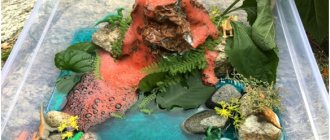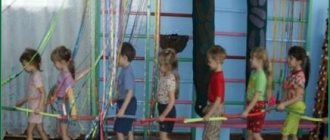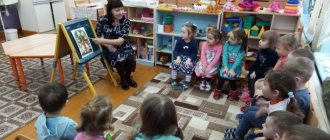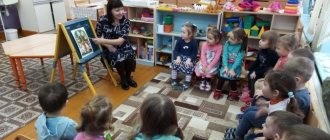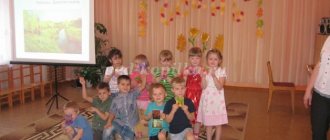Lesson “About volcanoes” for children
Experienced teachers have many ways to instill in a preschooler a love of science. These include working in a “children’s laboratory”, conducting scientific experiments, and simple experiments. By independently experimenting with substances and observing physical phenomena, children not only acquire knowledge about the world around them. They learn to think outside the box, exploratively, and can sometimes surprise with their logic.
One of the interesting topics about nature for children is volcanoes. The amazing world of these natural phenomena will not leave any child indifferent. And practical experience under the guidance of a teacher will delight even the most passive students.
Audience: preschoolers 5-6 years old
Props:
- Slides or posters about the structure of volcanoes, books about volcanoes for children, drawing sheets, pencils, markers, paints, brushes.
- Kit for conducting the experiment (basin or deep bowl, jar or bottle, water, cardboard, tape, soda, vinegar, dishwashing detergent, food coloring).
Progress of the lesson
The teacher begins the lesson with a riddle about a volcano:
-I throw stones, lava,
I am a dangerous giant!
Famous for its bad reputation.
What's my name? (Volcano)
- Children, today we will learn a lot of interesting things about volcanoes, what they are made of, how they sleep, erupt, and change the nature around them. In our laboratory we will conduct a magical experiment and see how lava flows out of a volcano, and at the end of the lesson we will have a quiz with questions about volcanoes. Do you love experiments and quizzes? At the end of the lesson, we will also play the game “Volcanologists”.
— What is a volcano? Maybe someone already knows?
This is a large natural mountain with a hole at the top from which hot streams pour out onto the surface of the earth.
— Where did the name Vulcan come from? The ancient people - the Romans - had a God of fire named Vulcan and he lived on the island of Vulcano in a country that is now called Italy. The god Vulcan commanded fire and lightning, and helped blacksmiths use fire to make objects from iron.
Here the teacher draws the attention of preschoolers to slides or posters about the structure of volcanoes.
—What does a volcano consist of? You and I already know that a volcano is a big mountain. It has a hole - a vent, from which hot, red-hot rock - lava - flows. The top of the vent is called a crater. It is located at the very top of the mountain. And below the mountain-volcano there is a huge cave with a hot substance called magma.
— Why do volcanoes erupt? Magma accumulates in the cave, begins to boil, rises up the vent and pours out onto the ground through the crater, turning into lava. Along with the magma, columns of smoke and volcanic ash erupt from the volcano, and hot stones fly. The whole earth around becomes gray and lifeless.
Physical exercise “Volcanic eruption”
- Let's imagine how a volcano erupts! Let's all sit on our haunches or on the floor. We are magma in an underground cave. Now let's start boiling and seething. We will splash our hands in the air and try to jump up. So the volcano is trembling, preparing to erupt. Now let our volcano burst out through the vent. Children jump up and raise their hands up. Magma poured out of the vent through the crater and spread over the ground, becoming lava.
Interesting facts about volcanoes
— And now interesting facts about volcanoes . They are active and dormant (extinct). Active volcanoes are those that have erupted in the last 10 thousand years and may still wake up and spew lava. Sleeping volcanoes will never wake up again. All volcanoes are studied by scientists - volcanologists; they are the ones who make predictions about what will happen next, whether the volcano will erupt or go dormant.
— The largest volcano on the planet, if you count the height from sea level, is Ojos del Salado . Its height is 6887 meters. It is located in South America and is considered dormant and extinct.
— The most dangerous volcano is located in Mexico, it is called Popocatepetl . Can you repeat this word? Volcanologists expect that he will someday wake up and erupt lava. Popocatepetl can kill a lot of people.
— In the Canary Islands there is a volcano on which a restaurant was built, and people cook food right on the fire of the volcano! They grill shish kebab and fish and treat the guests!
Now let's try to make a volcano erupt ourselves!
Children's laboratory experience
The teacher makes a model of the volcano in advance of the lesson or during the lesson with the children.
A basin or tray is placed on the table. This will be an island. The cardboard must be rolled into a cone and the seam sealed with tape or glue. The tip of the cone - cut off the crater with scissors. The cone can be coated with plasticine, so it will look like a real volcano. Place a bottle at the bottom of the basin under the cone, pour a tablespoon of soda into it, and pour in dishwashing detergent (25 ml). You can pour pebbles, sand into a basin around the mountain, and place animal figures. This way the picture will be more realistic.
In a mug, dilute food coloring (can be red or orange) with water and pour everything into a bottle under the volcano with the other ingredients. This way the magma will be ready.
And now the most important thing: pour vinegar into the mouth of the volcano and watch the eruption!
Here the teacher needs to be careful, it is important not to spill the vinegar and not allow the children to inhale this liquid.
Mixed with baking soda and dish soap in a bottle at the base of the volcano, the vinegar will create a rich foam from the volcano that will flow down the mountainside.
If you add baking soda and vinegar, the volcanic eruption can be repeated several times. Children will undoubtedly enjoy the spectacular experience.
After the experiment, it is advisable to ventilate the room.
Quiz
The quiz will help little researchers consolidate their acquired knowledge. Questions:
— Where did the name “volcano” come from?
— Which artisans did the god of fire help?
— What is the name of the hot substance in the cave under the volcano?
— What is the name of the long hole in a volcano through which magma rises?
- What is a crater?
— What does the magma that flows from the crater of a volcano turn into?
— What types of volcanoes are there?
—Who are volcanologists?
— What is the name of the largest volcano on the planet? Such a difficult word...
— What is the name of the most dangerous volcano?
Game "Volcanologists"
The most active participants in the quiz can be nominated as scientists - volcanologists. Let it be a girl and a boy.
Now you need to choose 3 - 4 strong boys who will firmly hold hands and form the mouth of a volcano. Their task is to hold their hands no matter what and not break the circle.
Volcanologists need to fill the volcano with magma. To do this, they call the rest of the participants into the mouth. A girl - a volcanologist - takes other girls by the hands and leads them into a circle - the mouth of a volcano. And the boy, a volcanologist, brings the boys, “pushing” them into the crater.
Circle - the muzzle stands firmly, without unclenching his hands. Children will have a lot of fun climbing into the circle and crowding around there; at this time the volcano is already seething, preparing to explode.
Everyone who did not fit into the crater can be called dinosaurs; they wander around the volcano. As soon as the vent overflowed, everyone who could entered the circle, the magma tore the vent - the volcano erupted, the children jumped out or fell out of the circle onto the floor. It's so fun!
Maybe now volcanologists themselves will choose an assistant and be the vent?
At the end of the lesson, the teacher invites the children to look at books about volcanoes for children with illustrations. Based on the knowledge they have acquired, children can themselves draw a volcano and the process of its eruption, using sheets of paper, paints, felt-tip pens, and pencils.
So, from the drawings in kindergarten, you will get an almost real scientific and educational exhibition about volcanoes for children.
How does an eruption occur?
A typical volcano is a hill with a pipe running through it, called vent . This vent rises from a magma chamber . lava - rushes up the vent and is thrown into the air . This phenomenon is called a volcanic eruption . Sometimes, along with an eruption, rain falls, which, mixed with ash, turns into rivers of mud. Lava melts rocks and destroys all living things, and after the eruption it hardens into a hard crust. As these solid layers accumulate, the volcano grows. But a volcanic eruption is not always accompanied by a lava flow; sometimes it can be done without it.
Mount Kilimanjaro is the highest point in Africa. This snow-capped, extinct volcano stands out from the surrounding lowland savannahs.
Geysers
Hot springs often appear around volcanoes, even long-dormant ones. If there is a cavity underground where underground water accumulates and heats up, a geyser is formed - a source that periodically releases fountains of hot water and steam. Pressurized water in underground voids gradually heats up above 100 °C. When it reaches a critical temperature, it boils. The resulting steam noisily ejects from the geyser, carrying boiling water with it.
In Yellowstone Park in the USA there is Lolina geysers, in which there are more than 3000 of them. The famous Vieux Fidel geyser throws out a hot water column 50 m high almost every hour. And the Giant geyser gushes for 7 minutes at different intervals and reaches a height of 61 m.
Share link
Classification and structure
All volcanoes, according to the nature of their activity, are active, dormant and extinct. And by location - terrestrial, underwater and subglacial.
To understand how a volcano forms, you must first take a closer look at its structure. Each volcano consists of the following elements:
- Vent (the main channel in the center of the geological formation).
- Dyke (channel with erupted lava).
- Crater (large hole at the top in the form of a bowl).
- Volcanic bomb (solidified pieces of erupted magma).
- Volcanic chamber (an area below the earth's surface where magma is concentrated).
- Cone (the so-called “mountain” formed by erupted lava and ash).
Despite the fact that the volcano looks like a huge mountain, its underground part is much larger than what is on the surface. Craters are often filled with water.
Largest eruptions
The eruption of Mount Tambora , located on the Indonesian island of Sumbawa, which occurred in 1815, is considered the most powerful in human history. The explosion of the volcano was heard on the island of Sumatra, that is, 2 thousand km from Tambora! More than 70 thousand people died because of this disaster.
The newly rebuilt city of Saint-Pierre next to the active volcano Mont Pelée in Martinique
Mont Pelee volcano , located in the northern part of the island of Martinique, suddenly woke up on the morning of May 8, 1902 and covered the nearby city of Saint-Pierre with a hot cloud of pellet and gas. As a result of the eruption, about 30 thousand people died.
Volcano Nevado del Ruiz , located in Colombia, has repeatedly presented residents of nearby settlements with unpleasant surprises in the form of eruptions. However, on November 13, 1985, the volcano raged in earnest. It produced a powerful emission of burning rocks, which melted glaciers and caused mud flows. They, in turn, destroyed the city of Armero, which stood 46 km from the source of the eruption. As a result of the disaster, about 25 thousand people died.
Ruins of the city of Pompeii. Almost all the inhabitants of the cities of Pompeii and Herculaneum died as a result of the terrible eruption of Mount Vesuvius, which occurred on August 24, 79 AD. e.
Yellowstone Caldera
The structure of the Yellowstone caldera
The Yellowstone Caldera is one of the largest known volcanoes in the world, and it is not just one volcano, but an entire system. It is located in North America. Calderas are large, crater-like basins formed after the collapse of the top of a long-dormant or extinct volcano. The size of the giant Yellowstone caldera is about 55x72 km. The first powerful eruption of the supervolcano occurred 2.1 million years ago, then 1.3 million and 640,000 years ago. Now there are from 1 to 20 earthquakes a day, but they are very weak - with a magnitude of no more than 3 points.
What is the danger?
Active volcanoes are dangerous for a number of reasons, some of which are not obvious. During periods without eruptions, they release a lot of gases, which are undesirable for people and animals to breathe. Dormant volcanoes pose a huge danger, as they can wake up at any moment. Because of this, it is very unsafe to settle near a volcano if it is not extinct. Even if it last erupted thousands of years ago. However, it is beneficial for people to live in volcanically active areas. Below we will tell you what the benefits are.
Now scientists have learned to predict eruptions, but predictions cannot be one hundred percent accurate. The extent of the disaster depends on many factors, such as location. If a volcano is located on an island, then its eruption is highly likely to trigger a tsunami. So one cataclysm turns into a whole series of disasters. However, volcanism can be useful, and humanity is actively using it.
What are they?
There are many classifications of volcanoes, the primary ones being by shape and type. To get a complete description of a volcano, you need to know how the lithospheric plates move underneath it, what the composition and viscosity of the lava is, and how quickly it hardens.
By type they are active, extinct, and also dormant; they are not extinct, but they are not active at the moment. Much depends on the form. The largest are shield ones, the diameter of their base is simply gigantic, their height can reach 17 kilometers. The walls are gentle, consisting of many layers of lava. On their slopes there are often small cone volcanoes up to 500 meters high. However, stratovolcanoes, like Kilimanjaro, are also of the cone type, and their height can reach up to 2500 meters. There are also domed ones, they are not high, but with steep slopes.
Another important characteristic is the type of crater. It may be a lava plateau or caldera, a volcanic plug or a tuff cone. The type of crater determines the danger an eruption poses.
